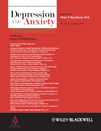The Cutting Edge
RECURRENCE RISK IN MAJOR DEPRESSION
Scott B. Patten M.D., Ph.D.,
Corresponding Author
Scott B. Patten M.D., Ph.D.
Correspondence to: Scott B. Patten, M.D., Ph.D., Department of Community Health Sciences and Department of Psychiatry. Member, Hotchkiss Brain Institute. University of Calgary, TRW Bldg., 3280 Hospital Drive NW, Calgary T2N-4Z6, Canada. E-mail: [email protected]Search for more papers by this authorScott B. Patten M.D., Ph.D.,
Corresponding Author
Scott B. Patten M.D., Ph.D.
Correspondence to: Scott B. Patten, M.D., Ph.D., Department of Community Health Sciences and Department of Psychiatry. Member, Hotchkiss Brain Institute. University of Calgary, TRW Bldg., 3280 Hospital Drive NW, Calgary T2N-4Z6, Canada. E-mail: [email protected]Search for more papers by this author
REFERENCES
- 1Frank E, Prien RF, Jarrett RB, et al. Conceptualization and rationale for consensus definitions of terms in major depressive disorder. Remission, recovery, relapse, and recurrence. Arch Gen Psychiatry 1991; 48(9): 851–855.
- 2Hardeveld F, Spijker J, De GR, Nolen WA, Beekman AT. Prevalence and predictors of recurrence of major depressive disorder in the adult population. Acta Psychiatr Scand 2010; 122(3): 184–191.
- 3Rush AJ, Kraemer HC, Sackeim HA, et al. Report by the ACNP Task Force on response and remission in major depressive disorder. Neuropsychopharmacology 2006; 31(9): 1841–1853.
- 4 American Psychiatric Association. Diagnostic and Statistical Manual of Mental Disorders (DSM-IV-TR). Washington: American Psychiatric Association; 2000.
10.1176/appi.books.9780890423349 Google Scholar
- 5Vos T, Haby MM, Berendregt JJ, Kruijshaar M, Corry J, Andrews G. The burden of major depression avoidable by longer-term treatment strategies. Arch Gen Psychiatry 2004; 61: 1097–1103.
- 6Patten SB. A major depression prognosis calculator based on episode duration. Clin Pract Epidemiol Mental Hlth 2006; 2: 13. http://www.cpementalhealth.com/content/2/1/13
- 7Andrade L, Caraveo-Anduaga JJ, Berglund P, et al. The epidemiology of major depressive episodes: results from the International Consortium of Psychiatric Epidemiology (ICPE) Surveys. Int J Methods Psychiatr Res 2003; 12(1): 3–21.
- 8Cheng H, Lee S, Tsang A, et al. The epidemiological profile of alcohol and other drug use in metropolitan China. Int J Public Health 2010; 55(6): 645–653.
- 9Moffitt TE, Caspi A, Taylor A, et al. How common are common mental disorders? Evidence that lifetime prevalence rates are doubled by prospective versus retrospective ascertainment. Psychol Med 2010; 40(6): 899–909.
- 10King M, Walker C, Levy G, et al. Development and validation of an international risk prediction algorithm for episodes of major depression in general practice attendees: the PredictD study. Arch Gen Psychiatry 2008; 65(12): 1368–1376.
- 11Eaton WW, Anthony JC, Gallo J, et al. Natural history of diagnostic interview schedule/DSM-IV major depression. The Baltimore Epidemiological Catchment Area follow-up. Arch Gen Psychiatry 1997; 54: 993–999.
- 12Kessing LV, Andersen PK. The effect of episodes on recurrence in affective disorder: a case register study. J Affect Disord 1999; 53(3): 225–231.
- 13Mueller TI, Leon AC, Keller MB, et al. Recurrence after recovery from major depressive disorder during 15 years of observational follow-up. Am J Psychiatry 1999; 156: 1000–1006.
- 14Colman I, Naicker K, Zeng Y, Ataullahjan A, Senthilselvan A, Patten SB. Predictors of long-term prognosis of depression. CMAJ 2011; 183(17): 1969–1976.
- 15Patten SB. Major depression prevalence is very high, but the syndrome is a poor proxy for community populations’ clinical treatment needs. Can J Psychiatry 2008; 53(7): 411–419.
- 16Patten SB, Williams JV, Lavorato DH, Bulloch AG, Macqueen G. Depressive episode characteristics and subsequent recurrence risk. J Affect Disord 2012; 140(3): 277–284.
- 17Wakefield JC, Schmitz MF, First MB, Horwitz AV. Extending the bereavement exclusion for major depression to other losses. Arch Gen Psychiatry 2007; 64: 433–440.
- 18Meaney MJ, Szyf M, Seckl JR. Epigenetic mechanisms of perinatal programming of hypothalamic-pituitary-adrenal function and health. Trends Mol Med 2007; 13(7): 269–277.
- 19Dannlowski U, Stuhrmann A, Beutelmann V, et al. Limbic scars: long-term consequences of childhood maltreatment revealed by functional and structural magnetic resonance imaging. Biol Psychiatry 2012; 71(4): 286–293.




